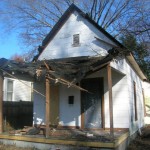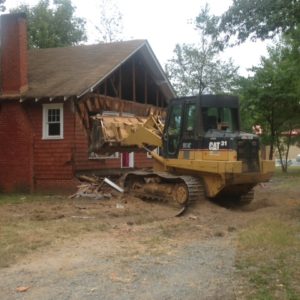 The reality is that no one is perfect: sooner or later a real estate investor is going to venture into a new direction, cut corners, and/or hit a cyclical pullback that will cause one’s investment in certain properties to be questioned. The likely hood of a lemon coming along is just an eventuality. What you do. How you react and face the adversity you face will determine if/when you reach your goals over time.This is an example of an investment gone bad, how the situation was accessed, and the coarse of action to stabilize it and create a return on investment until the full return of investment (or at a minimum -the capital investment itself) can be achieved. There are number of routes to take -I choose a direction to bring in an acceptable income while minimizing additional capital outlay.
The reality is that no one is perfect: sooner or later a real estate investor is going to venture into a new direction, cut corners, and/or hit a cyclical pullback that will cause one’s investment in certain properties to be questioned. The likely hood of a lemon coming along is just an eventuality. What you do. How you react and face the adversity you face will determine if/when you reach your goals over time.This is an example of an investment gone bad, how the situation was accessed, and the coarse of action to stabilize it and create a return on investment until the full return of investment (or at a minimum -the capital investment itself) can be achieved. There are number of routes to take -I choose a direction to bring in an acceptable income while minimizing additional capital outlay.
I believe that we learn from analyzing our mistakes -not from hiding them.
During the frenzied run up in the real estate market, I had funded an investors purchase (@$50k) of a 1 room old mill church in an up and coming neighborhood. At the time, it was rented to a small church that paid a majority of my clients interest cost and the goal was to land bank it over 2-3 years while lot pricing was running towards $75-90k. The church moved out. The rehab was never completed and my investor client saw his own business dominoes fall with the housing bust that hit our Charlotte, NC market with full force (from the Fall of 08′ through Spring 09′). Subsequently, I took ownership of the Church/house in the Fall of 09′ at a capital basis of @$37k.
Do you have an investment that hasn’t quite turn out the way you’ve envisioned? One must remember that we must focus on the long term with our investments too. Short-term it may look like a nightmare that over time may turn into a top performer. If you haven’t, I suggest you consider reading my article: Negative & Still Building Wealth.
Now this was a one room 7-800 Sq/Ft church with a side addition that housed a bathroom and small office. It sits on a gateway street (in Belmont) to the Plaza – Midwood neighborhood that supports $175-225/square footage housing prices (with some rehabbed homes interspersed up and down the Belmont block). The potential over time is there. Unfortunately at the time, the demand for lots (with a building to demo) were not in great demand. My thought to secure it and use it for storage over the short term was smashed as a tree fell taking out the front porch and causing some roof damage. It was not a total loss and insurance rebuilt the damage. At that point, I felt I would need to up-fit the building to finish the previously stalled rehab and correct the tree damage as the building was worth more to me up versus being a lot by itself. After-all, I could extract monthly rental income with a building versus a monthly mowing bill with nothing but a lawn on a vacant lot.
So we partitioned off a bedroom. Completed the office conversion into a kitchen and rehabbed the bathroom. It’s actually a pretty funky space with a big 15X20+ living room. After @$7k in rehab, the for rent sign went up and a ‘creative loafer’ signed a years lease for $425/mo. Now its not the greatest place with all the amenities or top quality craftsmanship; however, it is an affordable eclectic place located in an emerging market that attracts that young hip crowd that I often refer to.
My goal is to keep it rented providing a cash return on my investment while the market heals and either sell it with the ideal buyer being a new home builder and/or partnering with a builder to take to the next level. Recently, another investor paid $35k on a perfectly good home across the street, tore it down, and is rumored to build a new home. Heck -I was hoping my $27.5k offer was accepted with $7k in repairs to rent it out at $575+/month. To think I was beat out by someone who intends to build boggled my mind as better lots exist.
Typically, I would like to make a minimum 15%+ cash-on-cash investment return on my money. Having $44k into the investment (just assuming no debt) with a $5,100.00 gross annual rent income doesn’t quite make it does it? Just on that basis it would return 11.6%. However, I am missing some big components to the equation right? How about management, maintenance, repairs and/or reserving for future repairs, utilities, vacancies, etc., etc. As a generalization, I factor in a 27% (of rent) cost/expense factor to maintaining a rental. Sure you say its rented on a years lease; yet, one needs to look at how a rental will perform over a 3, 5, 10 year period. Odds are there will be a vacancy rate to factor in. I find that 27% is an average of all these potential expenses that my rentals cost me over time. So that being said, $5,100 annualized rent minus $1,377 (27%) equals $3,723 or an 8.5% cash-on-cash return. Now we all know one could goose the return using debt; however, for simplification I prefer to look at this as an all cash deal. This definitely doesn’t attain my goal at least for the short term; however, something is better than nothing.
The goal of assessing the situation, setting a course, and taking action towards that goal has been achieved. I see alot of investors react to the fear of failure by doing absolutely nothing. Some may still have this building sitting vacant and still damaged from the fallen tree with (perhaps) code enforcement threatening to demolish. Think it doesn’t happen? I see it all the time. Say the investor doesn’t have that $7k in rehab money I mentioned. I contend a good $5k of that was for labor. One has to use what assets they have to work with whether it be cash, time, or skills. At a minimum fix the tree damage so it doesn’t become a public nuisance and subject to code enforcement. You see the key is taking action and doing what you have to do.
We all get lemons from time to time. The key is taking action. Squeeze that lemon (by taking action) and make the best lemonade that you can with what you’ve got to work with.


